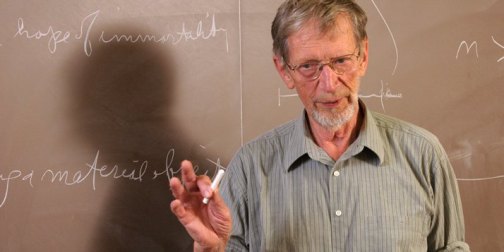On the fifth week of the 2017 AT Seminar Series Sameer Yadav, Assistant Professor of Religious Studies at Westmont University, delivered a paper titled “Love: Creaturely and Divine.” In his paper Yadav dealt with Schellenberg’s divine hiddenness argument by providing what could be called a “Plantingian Divine Imaging Defense.”
 Alvin Plantinga
Alvin Plantinga
An Overview of “Love: Creaturely and Divine”
Although not new, the problem of Divine Hiddenness (DH) became the subject of extensive philosophical discussion when J.L. Schellenberg published his book, Divine Hiddenness and Human Reason, in 1993. Schellenberg and others who put forth this argument appeal to existence of non-resistant non-believers as evidence for the non-existence of a perfectly loving God. We can summarize the main idea of DH as:
If God is perfectly Loving, then non-resistant non-belief does not exist. But it seems as though non-resistant non-belief does exist. Therefore, a perfectly loving God does not exist.
In his lecture Yadav pointed out that no one in the literature has noted that there is formal parity between the argument from DH and the logical problem of evil argument. Both arguments, according to Yadav, look something like this:
1.If God exists, God is essentially F
2.If God is essentially F then, necessarily, P
3.Not-P
4.Therefore, God is not essentially F (from 2 & 3)
5.Therefore, God does not exist (from 1 & 4)
Alvin Plantinga has already dealt with the logical Problem of Evil version of this argument. Plantinga has show that in order to make this deductive argument fail all one would need to show is that “God is essentially F and possibly, not-P.” In other words, one would need to show that permitting non-resistant non-belief is something a perfectly loving God might do.
Several such counter-examples have been deployed in recent years against DH, but as Yadav pointed out, most of these counter-examples have been anthropological counterexamples. They trade on the notion that loving human relationships resemble God’s loving relationships in significant ways. While this may or may not be true, Yadav attempted to do something that curiously hasn’t really been done in most responses to DH: give a properly theological counterexample. He showed that “God is essentially F and possibly, not-P” by showing that in a perfect loving divine relationship God need not prefer that the beloved enter into that relationship believing the proposition that God exists.
Yadav’s counter example is based upon his understanding of Divine Love as an imaging relationship. On this scenario God makes human creatures to resemble or mirror God’s beneficent rule over the created order. This imaging relationship is an invitation to a creaturely thing to resemble something divine. When humans respond appropriately to this call to image the divine, they enjoy a kind of communion with him. This is where Yadav’s argument begins to get tricky. He argues that it is possible to be aware of God’s action and this divine imaging relation without being aware that it is God’s action and that one is in a divine imaging relation. This is an appeal to the de re/de dicto distinction (concerning the thing/concerning the thing said). Yadav argued that there is a possible world where one might be acquainted with God de re, i.e. one images God, and that in this possible world it might be the case that one needs to be acquainted with God in a de re manner before one can go on to make a de dicto recognition about God, i.e. that one images God.
One way to think of how this de re/de dicto relation might work is to consider how children “image” their parents. A child, might be unaware that they are acting a lot like their mom or dad, but are in practice emulating their parent’s behavior. This would be a sort of de re imaging relationship. However, when the child grows up and has children of their own, they might come to realize “Oh my Gosh, I’m becoming just like my mom!” The realization that the child is imaging their parent is a sort of de dicto imaging relationship.
If this de re/de dicto difference in the recognition of one’s imaging God is a possible state of affairs, then one could argue that it might be the case that God is better served in an imaging relationship where de dicto recognition is not necessarily given to everyone, but is worked up to. It might be better for people to move from a de re state of affairs to a de dicto state of affairs on their own. If this is the case, then it appears as though we have a logically possible example of “God is essentially F and possibly, not-P.” This Plantingian type of response to the DH is enough to make the deductive argument from DH fail.
An Assessment of “Love: Creaturely and Divine”
When I’m not at Fuller I work as the college ministry director for a church in LA. A few weeks ago I was sitting with a college student at a coffee shop chatting about our religious beliefs. The student described himself as a non-resistant non-believer. He was coming to church regularly and he wanted to believe in God, but just couldn’t. He asked me, “If God is real, then why doesn’t he help me believe in him?” If you asked me to give you a clearer example of how significant the Divine Hiddenness problem is in real life I couldn’t do it. I was dealing with the reality of what for many people is a tricky philosophical problem. But DH is not simply a philosophical problem. It’s a deep existential problem for some people. The kind of work Sameer Yadav does in this paper gives people like me, who work in the church, a resource to deal with this issue. However, thinking back to my conversation with that college student I wonder whether showing that “God is essentially F and possibly, not-P” would have actually helped this student. We in the church need the kinds of response that Yadav and other analytic theologians are working on, however we also need answers that address the existential problem of divine hiddenness that non-resistant non-believers feel.
Advertisements Share this:




